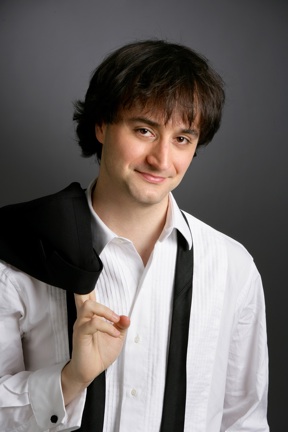A fine pianist in an excellent hall
Acoustics is curious—half art and half science. Actually, even the word is curious, as the plural can be singular, indeterminate as the wave phenomena it describes. Theoretically one can design a hall to match the instrument, or at least the size of the ensemble and its range. But theory and engineering seldom meet.
On Dec 14 young Israeli Ran Dank gave a piano recital at Merkin Concert Hall in mid-town Manhattan. Recently renovated by Robert Stern, the acoustics were superb. I sat in the small, steeply raked balcony and marveled at the full clarity of the sound. Low notes rumbled, apparently from all around me, and highs pealed drunkenly—that is to say, they were a little too sharply realized for polite company.
Four-foot squares of maple plywood floated under the ceiling, smoothing a sonic confusion of beams and HVAC ducts and shaping the sound, which was reflected off concrete wing walls.

Schooled in Israel, Dank got his Masters here in New York at Juilliard, studying first with Emanuel Ax and then with Robert McDonald. He warmed up with J.S. Bach’s French Suite No. 2, a gentle round of dances that Bach wrote as part of a large output of works honoring his patron Prince Leopold and the Prince’s gift to him of a new harpsichord. He gave the third dance, Sarabande, a lovely quality of living repose. Tension gathered in his pauses, and released in each careful note. Avoiding the syncopation of waltz, the Menuet was even and relaxed.
But then he threw restraint to the winds in Charles Ives’ Five Take-Offs for Piano. Ives wrote these dramatic and “mouthy” short works as a young man on a road trip. Accomplished and acidulous, they apparently spoke to Dank, who approached them with the off-hand brilliance of youth.
The Seen and Unseen? (Sweet and Tough) starts with chords familiar to that era (the Seen) and moves into complex note clusters that Ives had invented. Rough and Ready (and/or The Jumping Frog) used figures that got progressively more difficult, until his right hand was scrambling madly while the left became forceful and even pompous. Song Without (Good) Words was a cheeky take-off on Mendelssohn’s Songs Without Words, sweet and twisted. And Scene Episode was softly romantic, with beautiful dense language.
Ran Dank’s continued with Bela Bartok’s Sonata for Piano, No. 80. He was forceful and his off-beats jumped off the page. But it lacked that molten mania that Bartok demands, and that skirts sanity. By the Sostenuto he was channeling that edge, intimate and disturbing, and the Allegro molto was pretty wild.
In the second half of his long program, Dank ran through Chopin, Scriabin and Liszt to show off excellent technical chops. He brought energy and feeling to the Chopin Mazurkas, with a lightness that made the breakneck tempo feel relaxed. And in Chopin’s Waltz in A-flat Major, Op. 42, he returned dupal against triplets with gleeful finesse.
The presenter, Young Concert Artists, Inc., has nurtured the careers of many of today’s most distinguished musicians, from Dawn Upshaw to the St. Lawrence String Quartet, and for the last decade has also helped launch the careers of young composers. Next in this series is the New York debut of violinist Ray Chen, Tuesday January 12 at 7:30, also at this acoustic gem, Merkin Concert Hall.
—Adam Broner
Photo of Ran Dank by Andrew Chiciak
